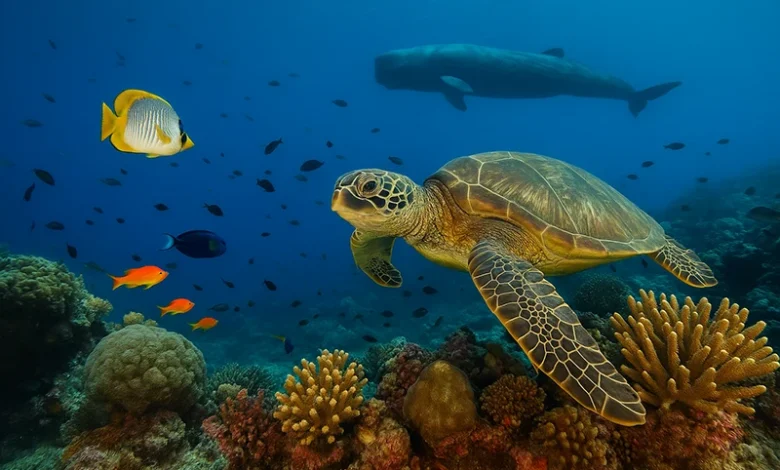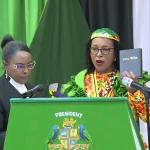Dominica’s Marine Biodiversity

Dominica’s Marine Biodiversity reflects the island’s unparalleled ecological richness and deep commitment to sustainable development. Often hailed as the “Nature Isle of the Caribbean,” Dominica is surrounded by vibrant coral reefs, thriving seagrass beds, and deep-sea habitats that support a wide array of marine life, making its waters some of the most biodiverse in the region.
Marine Ecosystems and Habitats
Dominica’s coastal and offshore waters host an array of interconnected habitats—coral reefs, seagrass beds, and mangroves—that sustain countless marine species and support biodiversity.
Coral Reefs
Dominica’s coral reefs are vital to its marine biodiversity, providing habitat for numerous marine organisms. These reefs host a variety of fish species such as parrotfish, angelfish, trumpetfish, and groupers, contributing to the marine ecosystem‘s health.
Seagrass Beds
Seagrass meadows around Dominica serve as crucial feeding grounds for marine life, including the endangered green turtle (Chelonia mydas). These habitats also act as nurseries for various fish species, supporting the island’s fisheries.
Mangroves
Mangrove forests along Dominica’s coastline provide essential services such as coastal protection, carbon sequestration, and habitat for juvenile fish and invertebrates.
Marine Species Diversity
From giant sperm whales to delicate coral dwellers, Dominica’s marine environment is home to a stunning range of fish, turtles, and marine mammals found across its waters.
Marine Mammals
Dominica’s waters are renowned for their resident population of sperm whales (Physeter macrocephalus), making the island a premier destination for whale watching enthusiasts. Other cetaceans commonly observed include spinner dolphins (Stenella longirostris), pantropical spotted dolphins (Stenella attenuata), and bottlenose dolphins (Tursiops truncatus). Less frequently sighted species encompass killer whales (Orcinus orca), false killer whales (Pseudorca crassidens), and humpback whales (Megaptera novaeangliae).
Sea Turtles
Several endangered sea turtle species nest on Dominica’s beaches:
- Leatherback Turtle (Dermochelys coriacea): The largest of all sea turtles, leatherbacks nest primarily on the island’s eastern beaches from March to August.
- Green Turtle (Chelonia mydas): Known for their herbivorous diet, green turtles nest between June and October, favoring both northern and southern beaches.
- Hawksbill Turtle (Eretmochelys imbricata): Recognized for their beautiful shells, hawksbills nest from May to October on various beaches across the island.
Fish and Invertebrates
Dominica’s reefs are home to a myriad of fish species, including parrotfish, angelfish, trumpetfish, and groupers, which contribute to the marine ecosystem’s health. Invertebrates such as sponges, lobsters, and sea urchins are also commonly found on coral reefs, playing vital roles in reef ecosystems by maintaining the balance between coral and algae growth.
Marine Protected Areas and Conservation Initiatives
To preserve its marine treasures, Dominica has established vital protected areas and partnerships that promote sustainable use, species protection, and resilient ecosystems.
Soufrière Scotts Head Marine Reserve (SSMR)
Established to protect the rich marine biodiversity in the southwestern region, the Soufrière Scotts Head Marine Reserve (SSMR) encompasses coral reefs, seagrass beds, and deep-sea habitats. The reserve supports sustainable fishing practices and promotes eco-tourism activities such as snorkelling and scuba diving. The Soufrière, Scotts Head, Galion Village Council has been a key partner in various conservation projects within the SSMR watershed, including stream restoration and community sensitization programs.
Dominica Sperm Whale Project
Collaborating with the Government of Dominica, this initiative aims to implement a marine protected area designed to manage human interactions with whales, build sustainable tourism, and protect the sperm whale families off Dominica.
Dominica National Conservation Trust Fund (DNCTF)
The Dominica National Conservation Trust Fund (DNCTF) provides sustainable funding to support the conservation, restoration, and management of Dominica’s marine and terrestrial ecosystems. It offers grants to local NGOs, community associations, government agencies, and other entities engaged in biodiversity preservation.
Government Agencies and Policies
Dominica’s marine governance is shaped by strategic policies and institutions that guide conservation, enforce protection, and promote long-term sustainable use of marine resources.
Environmental Coordinating Unit (ECU)
Functioning as the coordinating body for all environmental and sustainable development programs in Dominica, the ECU works alongside the Ministry of Environment, Rural Modernisation, and Kalinago Upliftment to implement policies that protect marine biodiversity.
National Ocean Policy (NOP)
Dominica’s NOP establishes a framework for integrated marine planning and management of the country’s marine space and activities from 2020 to 2035. It guides decisions related to marine resource use, ensuring sustainability and environmental protection.
Community and NGO Involvement
Local communities and non-governmental organizations play a pivotal role in marine conservation efforts:
- Beach Clean-Ups and Coral Restoration: Environmental NGOs collaborate with schools and youth organizations to conduct beach clean-ups, coral transplanting, and workshops on marine life, embedding conservation values in local culture.
- Eco-Tourism Initiatives: Organizations work with eco-friendly resorts to develop turtle-watching programs and sustainable tourism practices that benefit both the environment and local economies.
Challenges and Future Directions
Despite robust conservation efforts, Dominica’s marine biodiversity faces challenges such as coastal pollution, overfishing, and climate change impacts. Addressing these issues requires ongoing research, community engagement, and the implementation of policies that balance economic development with environmental preservation. The establishment of marine protected areas and the expansion of conservation initiatives demonstrate Dominica’s proactive approach to these challenges, setting a precedent for marine conservation in the Caribbean.
The health of Dominica’s marine ecosystems is closely tied to its national identity and future. Ongoing conservation efforts preserve not just the sea’s richness, but also the traditions and livelihoods rooted in it.




